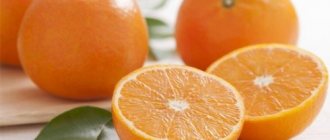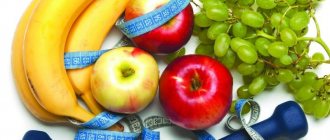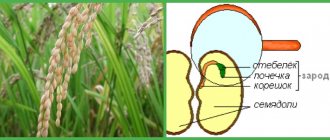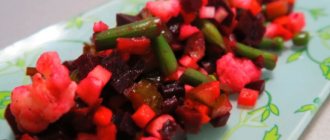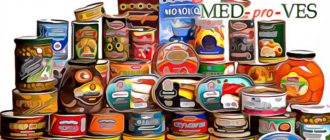- Benefit
- Harm
- Criterias of choice
- Weight loss plans
- Recommendations
- Recipes
In August-September, many people delight themselves with juicy, sweet melon. It perfectly quenches thirst in the summer heat, is tasty and healthy. It is during this period that many women think about whether it is possible to lose weight with its help. On the one hand, everyone is familiar with its diuretic effect and low calorie content. On the other hand, it contains so much sugar and carbohydrates. How do nutritionists solve this dilemma and what do they advise?
The main benefits of melon in the diet
- This is a product with a proven low calorie content: 100 g contains 33 kcal.
- The water content in it is quite high (about 90% of weight), which makes it an excellent means for losing weight and quenching thirst.
- Another unique property: enhancing the impact of antibiotics taken and weakening their toxic effects on the body.
- The vitamin composition of the pulp is amazing: B1, B2, B3, B6, B9 - normalize the functioning of the nervous system, relieve insomnia; vitamin A – good for skin and vision; vitamin C – strengthens the immune system; Vitamin E is a wonderful antioxidant that neutralizes the effects of free radicals; Vitamin PP is an obligatory agent for the occurrence of redox reactions in the body.
- Melon fruits contain real deposits of unsaturated fatty acids and antioxidants (lutein, zeaxanthin) - compounds that are directly involved in the metabolic processes of cholesterol, give youth and beauty to the skin and hair, and protect the eyes from the effects of oxygen free radicals.
- The set of micro- and macroelements is also worthy of attention: potassium, calcium, magnesium, sodium, sulfur, phosphorus, cobalt, manganese. And the iron content is 17 times higher than in cow's milk!
In terms of weight loss, the southern guest is primarily interesting for its ability to quickly break down fats - this is due to its unique combination of organic acids, plant fibers and the proportional composition of proteins, fats and carbohydrates.
But we should not forget that the benefits are fully manifested only in the case of its individual use, since it contains a large amount of food enzymes, and the main component - fiber, moves easily through the small and large intestines and produces a gentle cleansing. When the southern guest is consumed together with other products, there may be some complications in digestive processes, a feeling of heaviness in the stomach, and flatulence. For this reason, melon should be eaten separately, as a separate meal.
The combination of all these facts explains why this product is so readily used during express diets for weight loss. To all its advantages you can add accessibility and low cost in stores and markets.
How to choose the right quality fruits
The final result of losing extra pounds directly depends on the quality of the base product, so you need to pay special attention to this.
The use of insufficiently mature products should be avoided, as this can cause digestive upset.
Firstly, the degree of ripeness can be determined by the presence of melon aroma: the riper the fruit, the more pronounced and noticeable the specific honey aroma. Secondly, the sound when tapped should be muffled; ringing is a sign that the fruits were collected ahead of time and their nutritional value is therefore much lower. Thirdly, there should be no dents or cracks on the surface: this not only impairs the taste, but may be a sign of putrefactive processes inside. In the place where the flower was located, opposite the point of attachment of the stem, the peel may be softer and slightly springy when pressed, while the hardness of this area is a sign of immaturity. If there are many veins on the peel, this is a sure witness to the sweetness of the fruit.
During the diet, it is recommended to choose different varieties of melon, as this will ensure the supply of a more complete and varied set of nutrients and vitamins with a rather meager diet, since varieties differ in the content of vitamins, pectin substances, bioflavonoids and they may have different mineral composition.
Right choice
It is important not only to understand the benefits of vegetables, but also to choose them correctly.
Which must meet the following parameters:
- The selected fruit must be sniffed for the absence of a sour and musty odor. They also try to detect a grassy smell, which indicates that the fruit was picked unripe - perhaps it was not ripe at the time of sale.
- A melon, like a watermelon, should make a characteristic dull sound when tapped.
- A ripe melon has a dry tail.
- You can lightly press the melon - if your fingers sink a little, it means the skin is thin, therefore, the fruit is fully ripe and can be eaten.
In the latter case, it is forbidden to purchase a product whose skin is too thin - this indicates that the fruit is overripe, which means that you may encounter partial spoilage of the product inside.
Please note: You cannot buy melon that has already been cut - this will lead to poisoning, since bacteria develop on the cut. It is also not recommended to ask the seller to cut a melon - often their knives are not only not sterile, but also not washed as necessary using cleaning products.
Benefits of the melon diet
It is most rational to plan it for the end of August - beginning of September, since during this period this melon crop is sold in abundance in markets and stores. The seasonality of weight loss is justified by the lowest content of nitrates in fruits, which in other periods can be determined in quantities several times higher than the norm. In addition, due to the regulation of the production of certain hormones under the influence of consumption of the product, the severity of autumn depression decreases, and saturation with vitamins will help prepare for the winter season, with its viral and colds.
During the diet, you can eat not only the usual raw pulp, but also dried pulp. It contains all the same nutrients as fresh, and, despite the longer shelf life, does not lose its beneficial properties in terms of cleansing and toning the body. In addition to dried melon, you can also eat frozen melon. It can be stored in the freezer for a relatively long time - up to 3 months. After proper defrosting, you can use the product not only for single consumption, but also during the preparation of dishes, cocktails and drinks.
Since melon has a diuretic effect, it not only cleanses the kidneys, but also promotes the rapid removal of excess fluid from the body, which is a desirable process during diets: this allows you to lose weight in the shortest possible time and bring your body volume back to normal. Thanks to the laxative effect, the work of the gastrointestinal tract is regulated, toxic substances are eliminated, hematopoietic processes are activated, the level of hemoglobin in the blood increases, and the cardiovascular system is strengthened. Due to the intake of all necessary components into the body, the protective mechanisms of the immune system are activated, and the emotional state is balanced. It is also known that the melon component of the diet exhibits the properties of a strong aphrodisiac.
The melon mono-diet is a strict one, since the range of products is extremely limited. But for lovers of sweets, it serves as an excellent alternative and allows you to stay on course without giving up pleasure. Another important characteristic of the universal melon vegetable: consumption provides long-term satiety and, due to the feeling of fullness, you do not have to torture yourself with hunger.
When following a melon diet, fats are naturally broken down, the urinary system is cleansed, toxins are removed, and reliable prevention of atherosclerosis is ensured.
It is worth considering the diuretic effect of melon and not eating it in the evening, before bed, because the frequent urge to urinate will not allow you to get a good night's sleep. For this reason, it is better to organize dinner before 18-19 hours.
Useful tips
Doctors and people losing weight leave rave reviews about the melon diet, praising its cleansing effect and rapid weight loss. But to lose weight, you can use the diet no more than once every six months. During a low-calorie diet, dizziness, weakness, and nausea occur, so you should not overdo physical activity; walking in the fresh air is enough to keep fit.
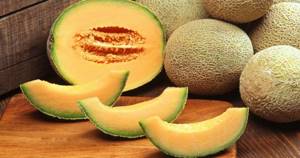
After completing the diet, you need to exit it correctly, without overloading the body with salty, smoked, and fatty foods. Otherwise, the weight will quickly return. Nutritionists believe that with such a mono-nutrition, the choice of melon itself is important.
THESE ARTICLES WILL HELP YOU LOSE WEIGHT
Your feedback on the article:
( 1,100 ratings, average: 4.48 out of 5)
Menu
There is a mono-diet and combined types. Melon is perfectly complemented by related vegetables: pumpkin, cucumber. Since melon pulp is an excellent source of energy, with this type of diet there is no feeling of fatigue and exhaustion, which improves mood and makes it easier to lose weight and reach the completion of the diet course.
The process of burning fat deposits begins to actively occur from the first days, and subsequently it is supplemented and consolidated. As a rule, the more excess weight you initially have, the faster the fat breakdown will occur and the weights can be more impressive.
Mono-diet for 3 days
This option is ideal for those who need quick and visually noticeable results. The basis is the daily consumption of 1-1.5 kg of juicy melons. Before breakfast, you need to divide this amount into 4 or 5 meals (breakfast, lunch, afternoon snack, early dinner, possibly a second dinner), which should be organized at equal time intervals. Drink 1.5-2 liters of water, tea, rosehip decoction per day. The loss is up to a kilogram per day.
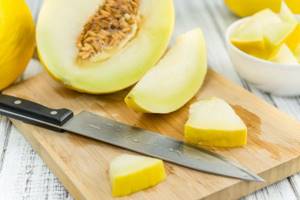
The same diet is sometimes used for seven days, but experts say that in this case you need to very sensitively pick up the body’s signals, since it receives significant stress due to a sharp reduction in the diet. If you still decide on a seven-day course, then it is better to combine it with taking a universal multivitamin complex.
Combined three-day
This option promotes not only weight loss, but also a pronounced detoxification process. It is more acceptable in comparison with the previous one, therefore it is easier to tolerate and does not threaten the body with possible overloads. Here the diet is less strict, it contains proteins and fats.
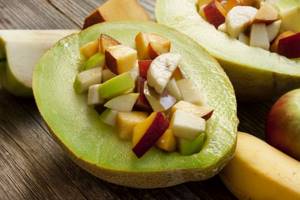
Day 1. For breakfast, eat 450 g of the main product. Lunch consists of a medium portion of melon-apple salad and unsweetened tea (preferably green). Lunch - 350 g of ripe melon and a piece of hard cheese. As an afternoon snack, you can have 1 kiwi and a cup of tea. Dinner: 100 g low-fat cottage cheese and 450 g melon. A couple of hours before bedtime, you can eat another piece of melon.
Day 2. For breakfast - a portion of ripe pulp of the main product weighing 450 g, second breakfast - kiwi-melon salad (250 g). Lunch consists of a piece of black bread, a piece of low-fat cheese and melon pulp (400 g). For an afternoon snack, repeat the melon intake, and for dinner, eat a salad of fresh vegetables with olive oil and apple cider vinegar, without salt (200 g).
Day 3. Repeated breakfast of 450 g melon pulp. Lunch - melon and kiwi salad with a slice of wholemeal bread. For lunch - boiled unsalted buckwheat without butter with a cup of green tea or another lunch option: you can eat 100 g of boiled chicken or turkey fillet with two slices of bread. For an afternoon snack - again 450 g of melon pulp, and for dinner - a couple of pieces of melon and a salad of fresh vegetables.
Cleansing 3-day
It not only gives you slimness, but also allows you to intensively cleanse the gastrointestinal tract and get rid of toxic deposits that complicate the processes of digesting food, absorbing nutrients and transporting undigested residues of masses moving through the small and large intestines.

Breakfasts and dinners should be devoted exclusively to 300-400 g of melon pulp. For lunch, treat yourself to a medium portion of vegetable soup, 100 g of boiled chicken fillet, a couple of cucumbers and wash it all down with weak tea without sugar. Vary the intervals between breakfast, lunch and dinner with tea, rosehip decoction, and herbal infusions.
For 7 days
The diet of such a diet is quite balanced and rational. The basis is the consumption of lean protein, limited amounts of fruits and vegetables.
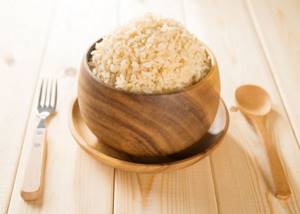
An infusion of fruits or berries is recommended as a drink. It is prepared as follows: pre-wash the fruits, peel them if necessary and cut into small pieces. Pour boiling water over and let sit for 10-15 minutes. This drink preserves all the substances that are destroyed during deep heat treatment, which makes it an excellent alternative to tea. You can also prepare decoctions of dried apricots and raisins, as they are tasty and allow you to speed up digestion.
This type of nutrition allows you to lose 3 kg in a week and at the same time maintain the result for a long time. The daily consumption of melon pulp is about 1.2 kg.
The indicative menu looks like this:
Monday
- Breakfast: brown rice, seasoned with soy sauce, berry infusion.
- Lunch: kiwi.
- Lunch: tomato-cucumber salad with bell peppers and onions, dressed with olive oil and lemon juice, tea.
- Afternoon snack and dinner: 400 g of melon pulp each.
Tuesday
- Breakfast: 2 tbsp. spoons of buckwheat, egg (preferably raw, soft-boiled), dried apricot compote.
- Lunch: chicken broth with herbs, boiled fish - 100 g, berry infusion.
- Dinner: 1 tbsp. a spoonful of mashed potatoes and a piece of melon, a glass of mineral water.
Wednesday
- Breakfast: boiled rice, egg, cranberry juice.
- Lunch: salad of boiled red beets with garlic and vegetable oil, 200 g of melon, compote.
- Dinner: a piece of beef – 200 g, 200 g melon.
Thursday
- Breakfast: oatmeal with raisins, tea.
- Lunch: vinaigrette, chicken fillet, melon smoothie.
- Dinner: stewed vegetables, kefir.
Friday
- Breakfast: barley, raw egg (can be soft-boiled), herbal tea.
- Lunch: vegetable soup with a piece of black bread, boiled chicken - 200 g, fruit infusion.
- Dinner: apple-melon puree, low-fat cottage cheese, compote.
Saturday
- Breakfast: vegetable puree, a glass of fermented baked milk.
- Lunch: vegetable stew and a piece of fish fillet with lemon juice.
- Dinner: 2 boiled potatoes, fresh cabbage salad, a piece of melon.
Sunday
- Breakfast: a couple of spoons of rice, an egg, herbal tea.
- Lunch: vegetable salad, baked apples with honey, fruit infusion.
- Dinner: baked pumpkin, melon smoothie.
For second breakfast and afternoon snack, eat two pieces of melon weighing 300 g each time.
Mono-diet
This melon diet for weight loss is the toughest. The menu consists exclusively of melon. With this diet, you only need to eat the pulp of the fruit. During the day you need to eat 1.5 kg of melon, dividing it into 5 meals. Other foods are completely excluded from the diet. During the entire diet you need to drink water, rosehip decoction and green tea without sugar.
Such a dietary restriction must be maintained for 2 days, the maximum period is 3. It is not recommended to stay on such a diet for a longer period, because it is psychologically difficult and can also harm the body itself.
According to reviews, with full adherence to the diet, you can lose up to 5 kg of weight.
Diet options
Watermelon-melon
The essence of this diet is that after each meal you need to eat dessert in the form of watermelon or melon. Both of them contain a minimal amount of calories, their composition is primarily water and they are great for fasting days or as a diet for those who want to get rid of body fat and lose weight. Despite the fact that they taste sweet, they contain very little sugar and it is not deposited at all on the sides and in the abdomen. Despite the similarity of characteristics, they should not be mixed into one meal. Thanks to their properties, these two berries provide more intensive cleansing of the kidneys, relieve swelling, help restore intestinal flora, and improve the body’s water and salt metabolism.
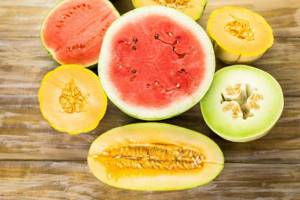
The downside is that with this type of nutrition there is often a need to go to the toilet, which must be taken into account when walking or traveling.
Between meals, snacks consisting of two main components are possible. You will have to temporarily give up salty, sweet, and baked goods; eat dairy products with caution to prevent stomach upset. Snacks should be allowed no more than three times a day. The total weight of melons should not exceed 1 kg per day.
In addition to the main components, the list of permitted products includes chicken, turkey, quail and pigeon meat, beef, mushrooms, low-fat fish (cod, hake, navaga, pollock, blue whiting, perch, pike, roach, pelengas, singil), low-fat cottage cheese and cheeses , brown rice, natural yogurt, quail and chicken eggs, vegetables (it is especially recommended to eat cabbage of different varieties), green beans, leafy greens, rye bread, black, green and herbal tea.
It is recommended to eat small portions every 2-3 hours. You should drink at least 4 glasses of still mineral water per day.
The course lasts 10 days. The result will be a weight loss of 2-4 kg.
The first five days are based on the consumption of watermelon, and from the 6th to the 10th - melon.
Approximate menu from 1st to 5th day
- Breakfast: watermelon, toast with a piece of low-fat cheese.
- Lunch: watermelon – 200 g.
- Lunch: 100 g of boiled beef, a small portion of brown rice with tomato sauce and Italian herbs. Dessert – 100 g of watermelon pulp.
- Afternoon snack: 200 g watermelon.
- Dinner: low-fat cottage cheese and watermelon.
Approximate menu from 6th to 10th day
- Breakfast: oatmeal on yogurt with almonds and berries.
- Lunch: 300 g melon.
- Lunch: vegetable soup with a 100-gram piece of beef.
- Afternoon snack: smoothie made from melon pulp and yogurt.
- Dinner: a few pieces of melon.
Cut melons should be stored in the refrigerator, wrapped in foil or in a bag: this way they will not spoil, will not lose moisture and will retain their beneficial properties.
Melon-kefir
The main components of this diet effectively help you lose weight, reinforcing the effect of each other; they guarantee quick loss of excess weight, give you slimness, and fight unnecessary centimeters in the hips and buttocks. In addition, they have a pronounced effect on the processes of cleansing and rejuvenating the body. Ideal for people who periodically have problems with constipation. This approach has proven itself to be balanced, useful, and not characterized by strict restrictions.

- Breakfast: 400 g melon.
- 2nd breakfast: a glass of kefir or low-fat yogurt.
- Lunch: a plate of brown rice without oil and salt, green tea, 400 g of melon pulp.
- Afternoon snack: thinly buttered toast, weak tea.
- Dinner: choice of buckwheat, pearl barley, rice or baked potato, vegetable salad and 200 g of dietary meat.
It is recommended to follow this diet for up to 7 days. During this time, you will be able to say goodbye to 5 kg of weight.
Cleansing
There are two interpretations.
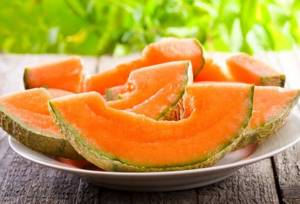
Option 1. Every day for breakfast you need to eat only 350-450 g of melon. For lunch and dinner, eat without deviating from your usual schedule, adhering to the principles of a healthy diet. Since such a diet is not strict, but maintains the supply of all necessary nutrients, along with a slight cleansing effect, it can be maintained for a long time, sometimes up to a month.
Option 2. In this case, the melon component (400 g) is for dinner, and breakfast and lunch remain the usual.
It is very good to use freshly squeezed melon juice instead of drinks and teas during this diet. It contains less dietary fiber and organic fruit acids, which is more gentle on the digestive system.
On melon and cereals
Most often, this diet is used for 5 days. Based on the predominant consumption of fiber and carbohydrates.
- Breakfast: melon pulp – 400 g.
- Second breakfast: a glass of kefir.
- Lunch: add a small portion of brown rice to your breakfast diet, followed by a cup of tea without sugar.
- Afternoon snack: black bread toast and 1 tsp. vegetable oil (it is better to alternate different types of vegetable oils every day).
- Dinner: 200 g of brown rice (barley porridge, oatmeal, buckwheat), 150 g of meat and fresh vegetable salad.

About calorie content
Having understood that melon is beneficial for the body, you need to familiarize yourself with the calorie content of the product. A table of caloric content and nutritional elements of this dietary product is presented in detail.
| Calorie content per 100 g | Proteins per 100 g | Fats per 100 g | Carbohydrates per 100 g |
| 33 | 0,6 | 0,3 | 7,4 |
Despite the fact that the calorie content of melon is low, it is recommended to eat it in the first half of the day for weight loss. In the evening, it is better to give preference to vegetables and berries, as well as foods high in protein.
Contraindications
Although the melon diet is gentle and healthy, it cannot be used by everyone. First you need to make sure that all contraindications do not affect the health status of a particular person. In general, cases of intolerance are extremely rare and are most often associated with growing crops and using fertilizers based on nitrate, which cause nitrate poisoning. Therefore, when buying a melon, you need to give preference to a seller who is obviously conscientious.
Use is prohibited when:
- diabetes mellitus;
- individual intolerance;
- breastfeeding period;
- infectious and invasive diseases of the gastrointestinal tract;
- liver dysfunction.
In any case, before using the diet, you should consult a doctor - following this simple rule will help protect you from many health problems.
Harm
Those who decide to lose weight with the help of melon need to familiarize themselves with the contraindications. Otherwise, consuming it in large quantities during a diet will cause harm to health, which will then have to be eliminated with the help of doctors.
Contraindications:
- diabetes;
- gastritis;
- ulcer;
- serious intestinal disorders;
- problems with the urinary system;
- lactation (the baby may experience indigestion);
- allergy.
Side effects:
- intestinal disorders;
- hypovitaminosis (if you sit on a mono-diet for a long time);
- flatulence;
- fermentation;
- bloating;
- exacerbation of existing diseases that are on the list of contraindications.
As soon as you feel any of the side effects, you should stop the diet and turn to other methods of body correction.
Did you know that... scientists still cannot come to a common conclusion about what a melon is - a berry, a fruit or a vegetable? According to the official version of botanists, today the last option is considered the most correct.
